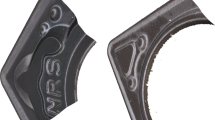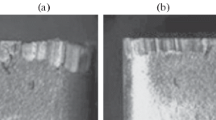Abstract
Chip formation in the turning of high-temperature chromium and nickel alloys is investigated as a function of the cutting speed and the structure and properties of the machined alloys, whose variation on heating is taken into account.
Similar content being viewed by others
References
Maslenkov, S.B., Zharoprochnye stali i splavy: Spravochnik (High-Temperature Steels and Alloys: A Handbook), Moscow: Metallurgiya, 1988.
Stroenie i svoistva aviatsionnykh materialov (Structure and Properties of Aviation Materials), Belov, A.F., Ed., Moscow: Metallurgiya, 1989.
Materialy v mashinostroenii. Vybor i primenenie: Spravochnik. T. 3. Spetsial’nye stali i splavy (Selection and Application of Materials in Manufacturing: A Handbook, Vol. 3: Special Steels and Alloys), Khimushin, F.F., Ed., Moscow: Mashinostroenie, 1968.
Tugoplavki materialy v mashinostroenii: Spravochnik (Refractory Materials in Manufacturing: A Handbook), Tumanov, A.T. and Portnoi, K.I., Eds., Moscow: Mashinostroenie, 1967.
Adaskin, A.M., Butrim, V.N., Kashirtsev, V.V., and Sapronov, I.Yu., Behavior of refractory chromium-base alloy Kh65NVFT, Metal Sci. Heat Treat., 2013, vol. 55, issue 7/8, pp. 409–414.
Poduraev, V.N., Rezanie trudnoobrabatyvaemykh materialov (Cutting Hard-To-Work Materials), Moscow: Vysshaya Shkola, 1974.
Adaskin, A.M., Butrim, V.N., Vereshchaka, A.S., Kashirtsev, V.V., and Kirillov, A.K., Cutting of high-temperature Kh65NVFT chromium alloy, Russ. Eng. Res., 2014, vol. 34, no. 2, pp. 122–126.
Adaskin, A.M., Vereshchaka, A.A., and Vereshchaka, A.S., Study of wear mechanism of hard-alloy tools during machining of refractory alloys, J. Frict. Wear, 2013, vol. 34, issue 3, pp. 208–213.
Bobrov, V.F., Osnovy teorii rezaniya materialov (Fundamentals of the Theory of Metal Cutting), Moscow: Mashinostroenie, 1975.
Vereshchaka, A.S. and Kushner, V.S., Rezanie materialov (Cutting Processes), Moscow: Vysshaya Shkola, 2009.
Marochnik stalei i splavov (Handbook of Steels and Alloys), Sorokin, V.G., Ed., Moscow: Mashinostroenie, 1989.
Ekobori, T., Failure Mechanics and Strength of Solids (Russian translation), Moscow: Metallurgiya, 1971.
McLean, D., Mechanical Properties of Metals, New York: Wiley, 1962.
Spravochnik instrumental’shchika (Tool Handbook), Ordinartsev, I.A., Leningrad: Mashinostroenie, 1987.
Author information
Authors and Affiliations
Corresponding author
Additional information
Original Russian Text © A.M. Adaskin, V.N. Butrim, A.A. Vereshchaka, A.S. Vereshchaka, V.V. Kashirtsev, 2014, published STIN, 2014, No. 10, pp. 23–27.
About this article
Cite this article
Adaskin, A.M., Butrim, V.N., Vereshchaka, A.A. et al. Influence of the cutting speed on chip formation in turning high-temperature chromium and nickel alloys. Russ. Engin. Res. 35, 298–301 (2015). https://doi.org/10.3103/S1068798X15040036
Published:
Issue Date:
DOI: https://doi.org/10.3103/S1068798X15040036




